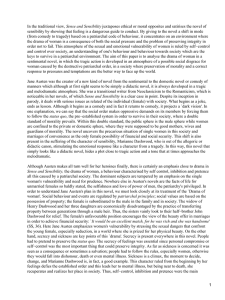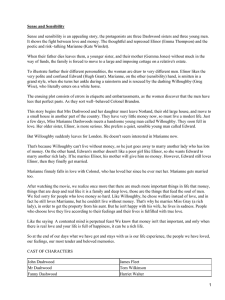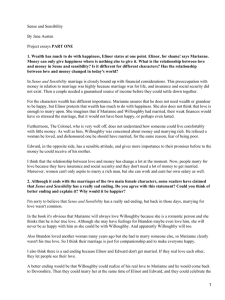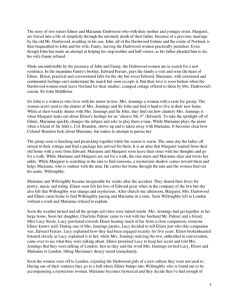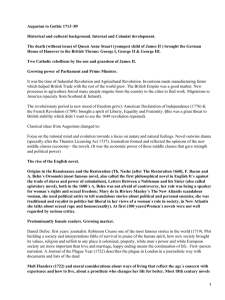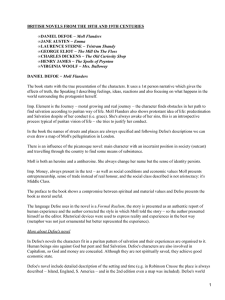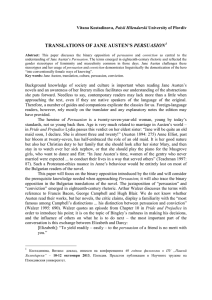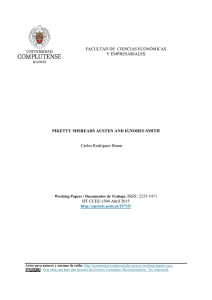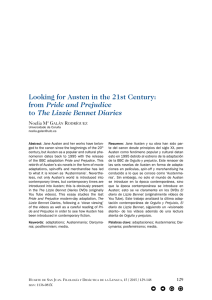Jane Austen
Anuncio
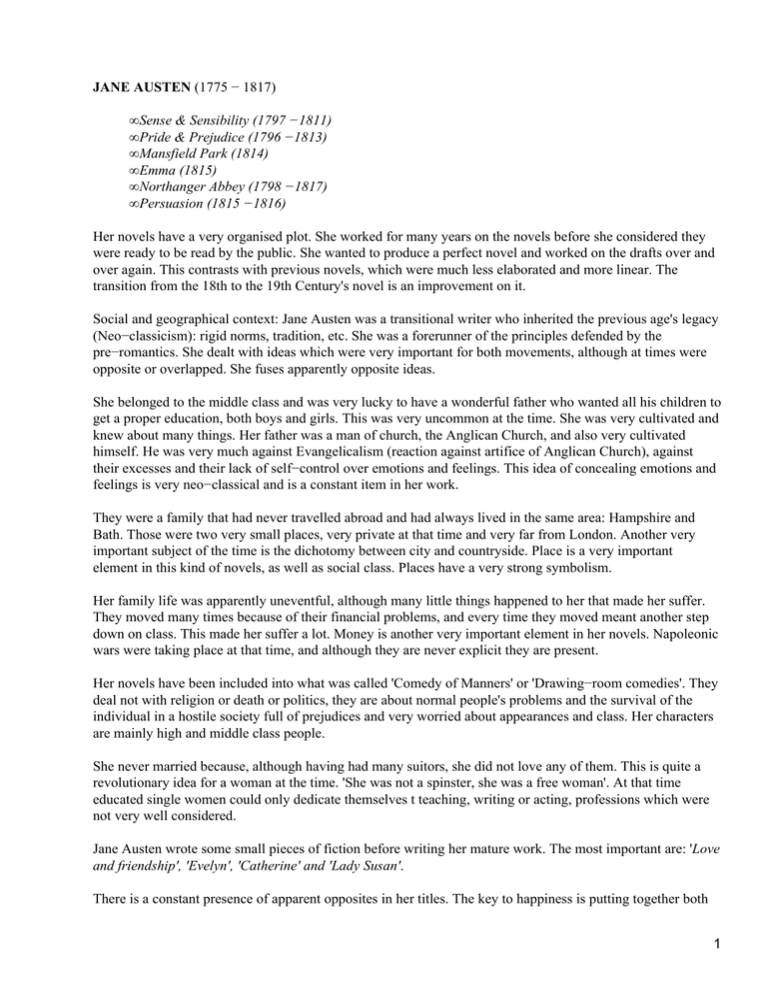
JANE AUSTEN (1775 − 1817)
• Sense & Sensibility (1797 −1811)
• Pride & Prejudice (1796 −1813)
• Mansfield Park (1814)
• Emma (1815)
• Northanger Abbey (1798 −1817)
• Persuasion (1815 −1816)
Her novels have a very organised plot. She worked for many years on the novels before she considered they
were ready to be read by the public. She wanted to produce a perfect novel and worked on the drafts over and
over again. This contrasts with previous novels, which were much less elaborated and more linear. The
transition from the 18th to the 19th Century's novel is an improvement on it.
Social and geographical context: Jane Austen was a transitional writer who inherited the previous age's legacy
(Neo−classicism): rigid norms, tradition, etc. She was a forerunner of the principles defended by the
pre−romantics. She dealt with ideas which were very important for both movements, although at times were
opposite or overlapped. She fuses apparently opposite ideas.
She belonged to the middle class and was very lucky to have a wonderful father who wanted all his children to
get a proper education, both boys and girls. This was very uncommon at the time. She was very cultivated and
knew about many things. Her father was a man of church, the Anglican Church, and also very cultivated
himself. He was very much against Evangelicalism (reaction against artifice of Anglican Church), against
their excesses and their lack of self−control over emotions and feelings. This idea of concealing emotions and
feelings is very neo−classical and is a constant item in her work.
They were a family that had never travelled abroad and had always lived in the same area: Hampshire and
Bath. Those were two very small places, very private at that time and very far from London. Another very
important subject of the time is the dichotomy between city and countryside. Place is a very important
element in this kind of novels, as well as social class. Places have a very strong symbolism.
Her family life was apparently uneventful, although many little things happened to her that made her suffer.
They moved many times because of their financial problems, and every time they moved meant another step
down on class. This made her suffer a lot. Money is another very important element in her novels. Napoleonic
wars were taking place at that time, and although they are never explicit they are present.
Her novels have been included into what was called 'Comedy of Manners' or 'Drawing−room comedies'. They
deal not with religion or death or politics, they are about normal people's problems and the survival of the
individual in a hostile society full of prejudices and very worried about appearances and class. Her characters
are mainly high and middle class people.
She never married because, although having had many suitors, she did not love any of them. This is quite a
revolutionary idea for a woman at the time. 'She was not a spinster, she was a free woman'. At that time
educated single women could only dedicate themselves t teaching, writing or acting, professions which were
not very well considered.
Jane Austen wrote some small pieces of fiction before writing her mature work. The most important are: 'Love
and friendship', 'Evelyn', 'Catherine' and 'Lady Susan'.
There is a constant presence of apparent opposites in her titles. The key to happiness is putting together both
1
extremes; this is one of the most important elements for the Romantic Movement.
Love and friendship is a parody of improbable romances that laughs at the very sentimental heroines of
previous times. It is against sentimental excesses of any kind. Very Neo−classical in tone, it deals with
propriety, social behaviour, etc. It was very controversial at the time because the idea in it was that friendship
was the basis of love.
Evelyn is the description of a dream, a reverie. This is a very much used technique by the Romantics. The
final message is that you cannot trust somebody who cannot cope with difficulties. Someone who is not
capable of having self−control in extreme situations is not worth our trust.
Catherine is a heroine that realises how you cannot trust appearances. She discovers that neither she, nor the
people around her are what she had thought them to be. It is a social critique.
Lady Susan has a very feminist tone. It deals mainly with a woman and her sad story when trying to learn, to
cultivate herself and the hostile society she has to live in. This work reminds us of Mary Wollstonecraft.
Jane Austen was very much influenced by Samuel Johnson (the man of letters of the 18th C). He represents
balance, culture, reason, order, tradition, and hierarchy, social values and love for the city. She was, at the
same time, influenced by William Cowper, who was completely the opposite of Johnson. He represents
feelings and freedom, spontaneity and experiences, individual values and struggles. He was a lover of the
countryside.
The most important of the literary convictions that she inherited from him was the concept of life and
literature. For Johnson, who was very optimistic, the fact that we cannot predict our lives does not mean that
we cannot control them, and that we cannot put some kind of order into them up to a point. Truth is always
found provided you are in possession of moral sincerity and a reliable judgement. If you have the right kind of
morals and the right kind of judgement you shall be happy. Their intention was to teach people, to instruct
them and through their teachings make them want to improve themselves.
This is the reason why 'fiction' dealt with portraits of real life. The closer the portrait was to reality the better
and the quickest it would reach people. This could seem to us quite a naïve idea because reality is not one;
there are as many realities as people there are. The instructive object of this kind of works implied that
language should be transparent and that words should mean what they meant and nothing else. Language is
not a main element; it is a transparent means of communication.
The influence that William Cowper exerted over Jane Austen can be seen on two different convictions.
According to Cowper, knowledge should be gained from life, from the experience you acquire living.
Experience is more important than academic education. This idea will be present in Jane Austen's work. The
second aspect is that he believed that nature was the key to happiness. Nature inspired the individual with the
right kind of feelings; it improves oneself through good sensations. Nature its God's projection. This is an
Evangelical idea and it is very much related to a very important, because of its influence, movement called
Benevolism, which was at its peak on the second half of the 18th Century. One of the 'heads' of it was J.
Shaftesbury. Benevolism is a reaction towards Hobbes' most dramatic and pessimistic ideas of mankind. For
them, human beings are gifted with a moral and aesthetic sense inferred on him by nature. For the Benevolists
nature implies a complete harmony of varied and opposite values. The importance of this movement is great,
because apart from changing the idea of what human beings were, they advocated for insane people, women's
rights, the working classes, etc. All this, affected the Romantics to a great extent.
As far as characters are concerned, in Jane Austen we will always find the same kind of characters.
Christopher Gillie made a taxonomy of her work. In it, there are five types of characters:
2
• The heroines: they are different from previous periods' heroines who were very soapy, sentimental
and did not seem to evolve psychologically. At this time heroines are normal women, not particularly
attractive or pretty, but they show some evolution: the go from immaturity to maturity by means of
critical self−discovery. They show two characteristics: endurance and generosity in contrast with
previous heroines. Romantic heroines are not interested in public display, they are only interested in
helping people and in noble actions, through which they improve as human beings.
• The heroes: they are a mystery to women because they occupied different spheres. There is a very
complex psychology on this point. There were two different types of men: the hero, a man who is
very respectful towards women, not particularly handsome, sometimes clumsy, and who is honest and
serious minded. This kind of man respects women and worries about their problems.
• The anti−hero: is a very funny person, attractive, handsome, just the person every one wants to have
at their parties. You cannot trust them, they only worry about themselves and do not respect women.
Sometimes anti−heroes correspond with prime antagonists.
• Prime antagonists: they represent the main obstacles that the heroine has to save. They are not always
hostile, they can even be friendly persons, nice and sympathetic. But they create confusion on the
heroine.
• Caricatures: they can be very hostile to the heroine but they are too stupid to be dangerous. They help
the reader to contrast their behaviour with the heroine's. They allow for parody and contribute to clear
things up.
• Minor characters: they are distant characters that remain in the background of the story and very little
is known about them.
Tony Tanner is another Jane Austen critic and has made another taxonomy or her characters:
There are three types of characters:
• Guardians: they are the old generation. They represent the 'old England', the aristocracy of the land,
the official values of the current times.
• Inheritors: they are the young generation, those who depend on the guardians.
• Interlopers: they are the new emergent middle−classes. Most often come from the city and embody
negative values.
According to Vivian Jones Jane Austen's novels can be divided into three different parts:
• Introduction: the main characters and settings are introduced to the reader.
• The different characters interact: they establish relationships up to a moment of crisis (climax)
• Analysis of effects and restoration of balance.
The main characters have a moment of anagnorisis (recognition of their mistakes) and they restore the
status−quo or climax. This point usually coincides with the prime antagonists in a celebration of a very
important assembly like a ball, a dinner party, etc, that can be very dangerous for the heroines. These kind of
assemblies mean a danger for them because of the hypocrisy held by the people around. Confusion appears
and it is difficult to survive in such a hostile society only worried about appearances.
V. Jones also says that the main characters learn by three different ways:
3
• Social interaction: the more relationships you have, the better, being isolated is dangerous.
• Introspection: reconsidering things, having an auto−critical attitude, etc.
• Observation: paying attention to all the things people say and do.
What place do Jane Austen's novels occupy in the history of Women Literature?
They were a literary subculture. Women Literature was not included in any academic canon together with
Black or Jewish, etc. We can notice three stages, according to E. Showalter:
Women literature tries to imitate the dominant ideological values. They look up to these values. There is an
internalisation of them: of femininity, duty, sensibility, intuition, spirituality, etc.
Women protest against these dominant values and speak against them, now they despise them. Political
activism.
And then another stage of self−discovery where a female culture is born.
SENSE & SENSIBILITY
Critics of the 1970's were not very fond of Austen's work, in fact, they thought it was very Neo−classical and
half way between burlesque and proper novel. The extreme separation of qualities like Pride and Prejudice,
Sense and Sensibility, etc., was radically despised saying that this attitude did not correspond to any real
individual. There was to big a gap between both terms for them to consider she was depicting any kind of
reality. Such an exaggerated confrontation of stereotypes does not give the desirable flexibility to a novel.
These extreme separations, relying on opposites, were an axiom of Neo−classicism and its purpose was to
make things clear to people. Their work intended to teach people, they had a didactic intention, both in poetry
and in prose.
Elinor and Marianne seem to embody the opposites, one is the representation of sense and the other of
sensibility. Nevertheless we cannot say that each of them has both qualities in a higher or a lower degree.
Qualities exist in isolation only as ideas, but in real life they co−exist, and this co−existence can result in one
situation or other.
Sense and Sensibility were two very much debated words at the time. They evoke the difference between
Neo−classicism and Romanticism, although both things were very important for both movements. Many
books were written on the subject because a great controversy raised about their meaning. The implications of
sensibility were much more complicated than those of sense.
For S. Richardson sensibility was a virtue because it allowed sensitive people to be detached from the
materialism they lived in (industrialisation, money, appearances, etc.) But it also had negative connotations, it
evokes hysteria, weakness, fragility, etc. The idea was to be sensitive but controlling your sensibility,
otherwise it would lead you to illness.
Sensibility was displayed on women characters and presented as something that confronts women's feelings
with their family responsibilities. The novel denounces how paradoxical it is to educate women to be sensitive
and then criticise them for it. Women are stupid because they are taught to be so. This reminds us very much
of Mary Wollstonecraft in her 'Vindication of the rights of Women' (1792) Austen was not as radical but
shared these views.
Motherhood and education is very important in this novel, they go hand in hand. Women who had received
the same kind of rational education were able to educate their kids properly. In the novel, mothers are
4
criticised, there is no balance, and either they have too little or too much. The absence of fathers is also
surprising. They are either dead or absent. The absence of paternal authority is what leads to such confusion of
the inheritors.
Austen's novels are very symmetrical and in this work we see how Elinor and Marianne are moved to
marriages with good and rich men, but this progress is complicated by the appearance of two prime
antagonists, Lucy Steele and Willoughby. The prime antagonists are married to other people and leave both
sisters to a happy end. The marriages of the heroines represent perfection, harmony, in contrast with those of
the other two couples which represent a kind of punishment. Nevertheless we will see later how the end of the
story suggests to the reader that Marianne has been led to 'her happy end' not so much willingly.
There are a lot of parallelisms in the novel:
Elinor and Marianne's lives. Both are engaged in difficult social situations where they are tested. Marianne is
tested when she meets Willoughby at the ball and Elinor when she has to stay in the same room with Edward
and Lucy at Mrs. Jennings' house.
Then Willoughby and Edward Ferrars who face, each of them, three options of marriage:
They both had a previous engagement: Willoughby with Eliza Williams (C. Brandon's daughter) and E.
Ferrars with Lucy Steele.
A financially advantageous marriage was possible for both: Willoughby with Ms. Grey and E. Ferrars with
Ms. Morton.
And they both had a genuine attachment: Willoughby to Marianne, which he makes it known to Elinor
although having married a different woman. And E. Ferrars to Elinor.
Both are cast off by their benefactor (W − Mrs. Smith, his aunt. E. F. − Mrs. Ferrars) But they have very
different characters, and only the 'good' one participates of the happy end.
Tony Tanner says that Sense and Sensibility is very much about secrecy and sickness.
The novel is full of secrets: Colonel Brandon has to abandon the excursion but he does not tell why. Lucy tells
Elinor the secret engagement. Willoughby never informs Marianne about his engagement with Ms. Grey, etc.
Secrecy is taken as a social game. People felt bored so they need to create some shadows, some mystery.
Secrecy of feelings and silence is something imposed by society. However you were asked to be very social
and talkative, but you were supposed to be reserved at the same time. Quotation no. 1 and 2
Marianne's illness is very important. Her behaviour is pathological but does not mean that it is exceptional.
Many people at the time were suffering from the same (Cowper). Tony Tanner relies on a thinker like
Foucault ('Madness and Civilisation'). Foucault gives evidence of the great increase of madness, nervous
breakdowns, and melancholic states that took place in those difficult years. He establishes three main reasons
for this:
One of economic nature: the new type of economy was responsible for all these cases of psychological
weakness. An emerging country of tradesmen and free trade with no Government interference implied that
many people started worrying about their financial situation. The gap between the poor and the rich was
getting bigger and bigger.
There was also a fatal emphasis on reason and sensibility, but sensibility understood as regulated by the
5
official ideology. Quotation no. 4. Sensibility was not spontaneous it was an imposition upon individuals.
The existence and popularity of a very particular kind of novels, the improbable romances, had its part of
blame in the increase of mental illnesses. Foucault says that these novels mostly affected women from the
upper classes who had the money to buy the book and the time to read them. Their excess of emotive scenes
and the excessive sentimentality was very pernicious for the people who read them. Quotation no. 5.
One cure for this illness was to expose the patient to nature to mitigate those excesses. Nature was healing; the
contemplation of landscapes and the peace found in the country were very helpful in contrast with the city and
the hypocrisy that polluted it. The society living in the city was ruled by money and appearances and had
nothing to do with the previous agricultural world. Elinor places Marianne in the middle of nature confident
that this would cure her.
Marianne's illness has a purpose in the novel. It makes clear that a nervous breakdown is something very
common in the first two decades of the 19th Century and it functions as a denunciation of the imposition of
sensibility upon women. It is also a subtle attack on civilised society that forgets about the spiritual sphere.
Marianne rejects all kinds of social forms, which she considers a masquerade. Quotation no.6. Social
manners, for her, should project the individual true feelings. She is conscious, however, that some kind of
rules must exist in society to find cohesion. There is a need to find a balance between privacy or individual
freedom and social life.
It has been said that those who reject norms are usually more influenced by them. Willoughby is depicted in
the beginning as a young lover who rejects and despises social norms, but at the end he turns into the opposite
because of his greed for money. Marianne is more sincere although very contradictory. Quotation no. 7. In
this passage we can appreciate that a Romantic character may not be so romantic if we analyse it. Financial
matters reveal a lot about characters. Elinor is realistic when speaking about money, but Marianne is more
materialistic.
Jane Austen's novels are full of symbols because of those highly organised plots. They make the reader
imagine what's going to happen, establish connections, and they add complementary messages. For example:
Marianne's hobbies are music and reading poetry; this is a sign of spirituality, spontaneity and keenness on
showing. Elinor's hobby is painting screens; what means that she is fond of hiding, composing herself. The
novel is not defending the fact that Elinor hid behind a screen it is denouncing the need to do it to protect
yourself from society. The question is how much control should society be allowed to exert on the individual?
The tension that results from people having to be very private and sociable at the same time is clearly seen on
the prominence that the novel gives to the gaze, to what is seen, to the eyes. Quotation no. 10. People are
always aware that someone is watching them. This creates a great deal of anxiety on individuals. In a world
with so many secrets, eyes have to be trained to obtain the correct perspective of things, the truth.
The wrong interpretation of insufficient evidence is also an important element in the novel. For example,
when Elinor sees Edward's ring and thinks it's an evidence of his true love for her. Jane Austen was very
critical of her society.
On the other hand, Marianne always makes sure that her intentions are made clear. She does all the wrong
things at the ball when she meets Willoughby. She reveals her agony through symptoms of illness, which she
does not attempt to hide.
Very often action is replaced by language. By playing with words, using irony, you can draw hints of what
you really think of the things you cannot or are not supposed to do. Irony compensates the individual for the
impossibility of action.
6
The novel systematically draws the reader's attention to the importance of language. Language conforms our
vision of the world so it is never aseptical, it always carries a great deal of ideological content. The quality of
life in a society depends on its language, on the way language has defined values, norms, etc. Language can
also inflict a lot of pain and sorrow and this novel is pretty aware of this fact.
Marianne's consideration of language made her close to the Romantics. Language for the Romantic
Movement implied the translation of unique thoughts into public norms, into something too standardised to
show the differences that convey each and every individual thought. For the Romantics, language is a kind of
falsification. The novel also sympathises with Marianne in the point that language should be used to express
feelings rather than social norms. However she admits that there should be some cohesion so that we can
prevent people misunderstanding our words, our behaviour. Precise definitions should exist to avoid
confusion. Clarification achieved by differentiation is put to the test in this work. Quotation no. 13. This
passage proliferates in comparatives and it results into a very confusing and heavy going thing.
In Quotation no. 14 is Elinor speaking, very much aware of decorum and linguistic forms she tries to define
the man she loves. In the beginning she does not want to reveal her love but the more she speaks the more she
gets involved, and then she goes back again into composure.
Language can also be a means of manipulation. In the passage where Fanny convinces her husband that he
does not have to help his family at all, she only uses language. Quotation no. 15 & 16. You must call things
what they are (a house is a house and a cottage is not a house) Robert Ferrars systematically confuses
commercial terminology with feelings. A valuable person for him is that who has money, that says a lot about
himself.
Willoughby is very inconstant although very good at language when socialising but, when it comes to
revealing his true feelings, he is unable to utter one word.
Elinor and Marianne usually show differences of opinion because they are projecting their own character.
Quotation no.16. Elinor's opinion on Colonel Brandon is a lot different from that of Marianne. They use very
different ways in order to convey their personal feelings.
Clarification through differentiation is something present in the novel, sometimes to criticise it and some
times using it. There are some paragraphs in the novel in which this device is ironically used, like in the one
where Willoughby is describing both sisters. It is full of comparatives and it results in a very confusing piece
of information. In the 18th Century language is used as means of achieving the truth, and by the end of the
Century, with the birth of Romanticism, language turns into an instrument to communicate feelings.
Quotation no.17 is another illustration on how language changes our point of view. Edward Ferrars speaks in
a practical and utilitarian terms. Marianne, instead, uses more sophisticated terms, more Romantic. This also
illustrates the co−existence of two ideological trends: Romanticism and Utilitarism. This contrast puts forward
the fact that nature can be both ways at the same time, it only depends on the point of view.
The two sisters have different attitudes towards movement. Elinor represents composure, stillness, and
Marianne instead is very fond of sports, running, etc. This fact points to the transitional aspect of this period,
Neo−classics were not very fond of movement and Romantics loved it.
Improvements are another important element in the novel. It states the improvements that have to be made to
improve nature. They should be done to make a place self−sufficient, to make a community more
comfortable, they should be undertaken for some useful purpose, just as Colonel Brandon did at Delaford. Mr.
J. Dashwood, instead, makes his grove at Norland into a flowerbed just for the sake of it, to show off.
The weakest aspect of the novel is the end. Marianne marrying Colonel Brandon is somehow weird, difficult
7
to believe, very unrealistic. Is it a punishment for being 'so Romantic'? Is this what too much sensibility leads
you to? Society exerted such pressure over individuals that sometimes they were abode to do things.
At this point in the Century, aristocracy is beginning to mingle with the emerging classes.
1
1
8
